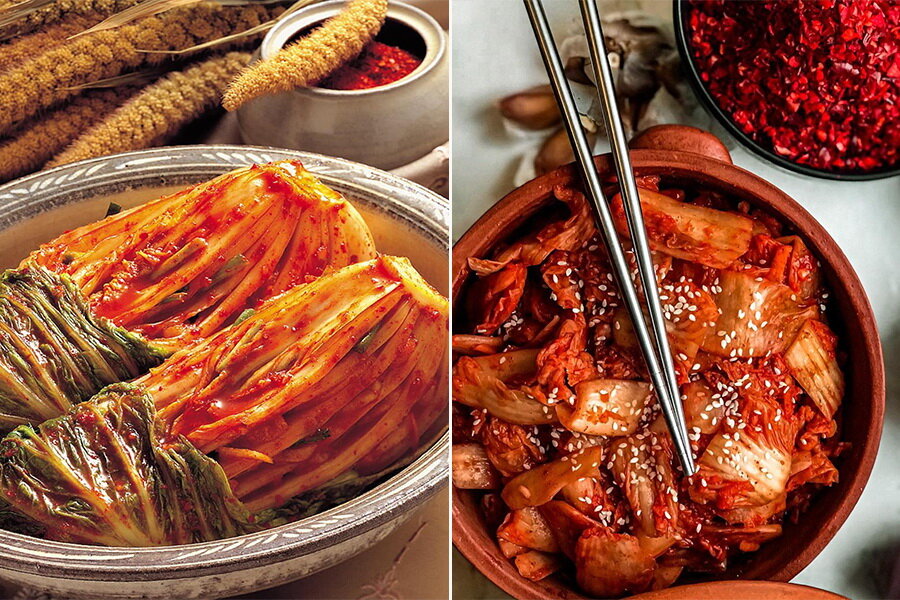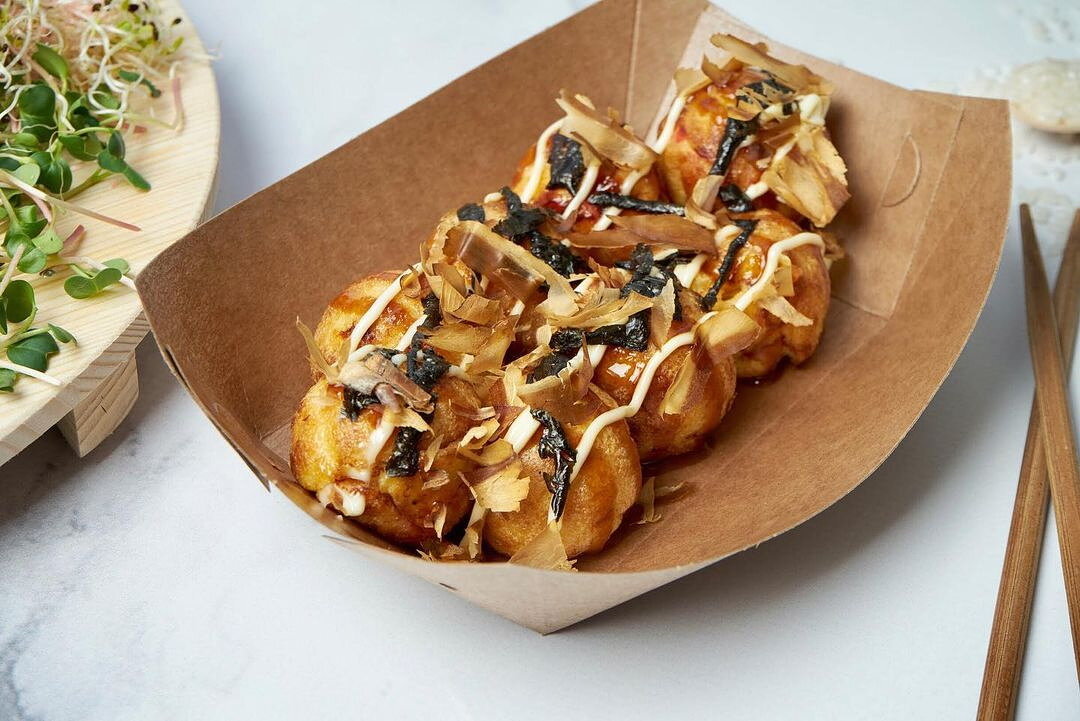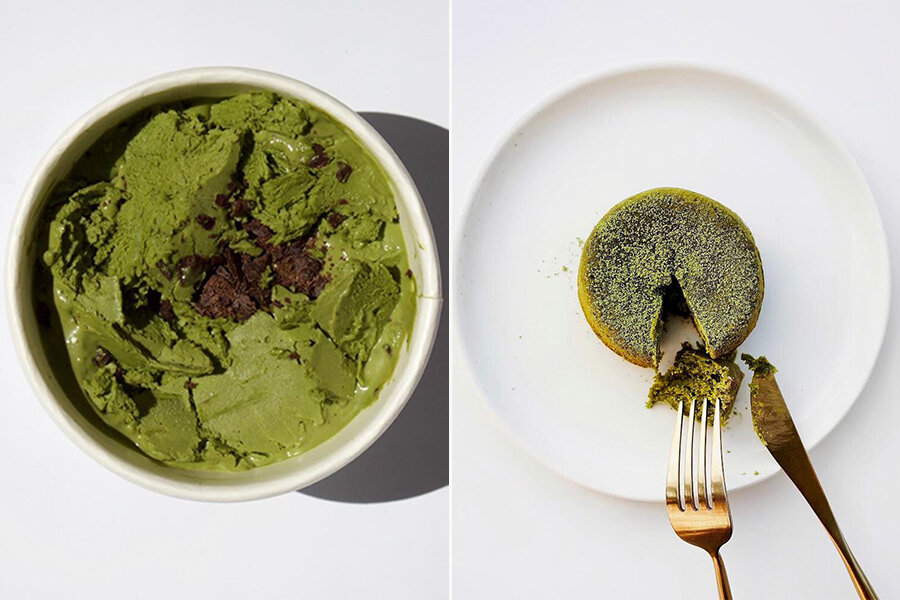From Japanese sushi to Chinese dim sum, the popularity of East Asian cuisine has gone through the roof over the last few decades.
Rich in history, traditional East Asian culinary practice has been gaining attention around the world. Taking a gastronomic tour in Asia is on the bucket list for many foodies out there, but the pandemic has made it difficult to fulfill their dreams.
Luckily, small businesses offering East Asian goodies have been popping up in Ukraine, introducing locals to new food traditions. Here is the Kyiv Post’s guide to productions and places to explore a taste of East Asia in the capital.

Onigiri rice balls, usually wrapped with seaweed and containing fish, meat or vegetable filling, are iconic snacks in Japan. (Kolobok Bo/ Instagram)
Kolobok Bo’s rice balls
When traveling to Japan, it’s hard to miss the convenience stores in almost every corner of any city, selling everyday necessities like ready-to-eat meals, bottled beverages and snacks. Locally called “konbini,” these one-stop shops are open round the clock and are known to be efficient and innovative, where customers can choose from many grab-and-go options, including a whole shelf dedicated to onigiri rice balls.
Much like sandwiches in Europe, onigiri rice balls, usually wrapped with seaweed and containing fish, meat or vegetable filling, are iconic snacks in Japan. In konbini, they are individually wrapped in plastic to ensure that the seaweed sheet stays fresh and crisp.
Japan’s rice balls are now also available in Kyiv thanks to the Kolobok Bo supplier. The company makes onigiris with six kinds of fillings, such as tuna with mayonnaise, teriyaki chicken and salmon kimchi. The Japanese snacks are then distributed to 25 cafés across the capital. They can also be bought directly from Kolobok Bo for Hr 65 ($2.3) apiece and delivered to one’s home.
One of the co-founders, Dmytro Oseledets, says that most people in Ukraine have not been introduced to onigiri yet, but he is optimistic that it will become a trend in the near future because “people always want to try something new.”
Kolobok Bo’s onigiris can be purchased through Instagram and have them delivered on Tuesday or Friday. They are also available at a number of cafes in Kyiv, which include Hand Brew Coffee (32 Bohdana Khmelnytskoho St.) and Kyiv Flower Project (20 Vozdvyzhenska St.)

The origins of Chinese mooncakes with a pastry skin enveloping a sweet, dense filling can be traced back to ancient times. (Mooncake_ua/ Instagram)
Chinese mooncakes
Traditionally eaten at the Moon Festival celebrated in fall, the small baked cakes — typically round, symbolizing the full moon — are presented as gifts to friends and acquaintances on this occasion.
Historians believe that the custom of eating Chinese mooncakes during the festival began in the Yuan Dynasty (13–14th centuries), the first foreign-led regime in ancient China ruled by Mongols.
According to a local folktale, mooncakes helped the Chinese people regain control of their territory even when they were being closely watched by the Mongols. It is believed that Chinese generals hid their messages in mooncakes to communicate while secretly organizing a revolt.
In Ukraine, Chinese mooncakes, famous for a sweet dense filling enveloped into a pastry skin, can be purchased from Mooncake_ua, a small manufacturer based in the city of Dnipro. The family business of Pavel Khedekel and his daughter Sofia Khedekel offers them at an affordable price and delivers to all corners of the country.
There are 10 types of fillings available, such as the authentic sweet azuki red bean paste, poppyseed and sugar-free alternatives like dates. Each of them is individually packaged in plastic and neatly packed in a box.
Mooncake_ua’s desserts are sold in a set of three for Hr 70 ($3.2), a set of five for Hr 90 ($3.3), a set of nine for Hr 150 ($5.5) and a set of 20 for Hr 290 ($10.6). Order through Mooncake_ua’s Instagram

Baker Fluffy located in Kyiv’s Dream Town shopping mall offers freshly-baked Japanese cotton cheesecakes in four flavors, which are vanilla, chocolate, raspberry and melon. (Volodymyr Petrov)
Fluffy jiggly cheesecakes
With the moist, cotton-soft texture of soufflé, Japanese cheesecake is catching the hearts of people around the globe. What began in 1985 at a small local cakery Uncle Tetsu in Japan has grown to a global hit, rapidly gaining popularity in social media.
There is usually a long line of customers hoping to get a taste of Uncle Tetsu’s freshly-baked signature desserts with the average wait time between 15 to 30 minutes.
Despite originating more than 8,000 kilometers away, Japanese cheesecake has also made its way to Ukraine. Inspired by the airy dessert from Uncle Tetsu, Alina Korchakova wanted to make “something that’s not in Ukraine yet” and opened a bakery specializing in Japanese taste.
Her Baker Fluffy has cheesecakes in four flavors, which are vanilla, chocolate, raspberry and melon. While vanilla and chocolate-flavored soufflé cakes come in two sizes (180 grams and 450 grams), the other two are only offered in a smaller size.
Korchakova says the cheesecakes are being baked every morning and only use fine ingredients. In contrast with the New York-style cheesecakes, the Japanese ones are lower in calories and the texture is “very fluffy,” according to the owner.
Baker Fluffy’s Japanese cheesecakes can be purchased for Hr 87 ($3) and Hr 215 ($7.7) online at www.bakerfluffy.com or at the physical location at Dream Town 1 shopping mall (1B Obolonskyi Ave., 3rd floor)

Kimchi made with spicy fermented vegetables is incorporated into a variety of dishes in Korea. (Kim's Kimchi/ Instagram)
Fermented Korean kimchi
The staple traditional Korean side dish made of fermented and salted vegetables, with its high probiotic and fiber content, has been around for over 2,000 years. The beloved East Asian recipe used to preserve vegetables helped ancient Koreans overcome cold winters.
Packed with nutrients while being low in calories, the dish offers a variety of health benefits, which include keeping the digestive system healthy, boosting the immune system and reducing the risk of serious conditions such as stroke and cancer.
Kyiv-based Garazade Elfag and his wife Tabriza Hasankhani have been making kimchi at home for nearly four years until they started a small family business in 2020, driven by their love for Korean cuisine. The selection of fermented vegetables at Kim’s Kimchi was first small, but the menu has been expanding ever since. Besides regular kimchi made of Chinese cabbage, the producer also uses other ingredients like green onion, cucumber and radish. Elfag says their kimchi undergoes a proper fermentation process but is cooked mildly spicy to suit the taste buds of Ukrainians.
About 900 grams of Chinese cabbage kimchi can be purchased for Hr 250 ($9) while the price is Hr 300 ($11) for kimchi made of green onions, cucumbers and radish. There is half-size green onion kimchi available as well for Hr 150 ($5.5). An order can be made by contacting Kim’s Kimchi through Instagram or by calling them at +38063 190 7040.

Takoyaki, small dumplings made of a savory pancake-like batter containing pieces of octopus, is a popular street snack in Japan.
Osaka’s octopus balls
The Japanese street snack in the shape of little round balls containing pieces of octopus originated in the city of Osaka back in the 1930s, where the irresistible smell of takoyaki spreads across the street now and then.
The small dumplings made of a savory pancake-like batter, garnished with sauces and seasonings, are popular at festivals, often prepared from food stands right in front of customers.
Ka Wing Leung, a 37-year-old Hong Konger who moved to Ukraine three years ago, is passionate about Japanese cuisine and wants to show Ukrainian people that it’s a whole lot more than sushi. Leung opened Kyiv’s first takoyaki stand in 2020, keeping the prices affordable whilst maintaining the food quality high.
Besides takoyaki, street vendor Octi offers other Japanese everyday food like onigiri with fried shrimp, bento box meal and grilled eel bowl.
A serving of takoyaki is sold for Hr 79 ($2.9), onigiri with shrimp/salmon for Hr 49 ($1.8) and eel bowl for Hr 169 ($6.2). 5 Yuriia Illienka St. TueFri. 12:45 p. m. — 8:30 p. m. Sat-Sun. 1:30 p. m. — 9:00 p.m.
Trendy matcha desserts

The Kasuteira production offers a number of Japanese confections, including matcha ice cream with dark chocolate chips (L) and matcha fondant (R).
Matcha has been an international phenomenon in the past few years, competing against coffee in a popularity contest. Set as a trendy flavor at the forefront of the dessert scene, it’s become more common to spot matcha-based sweets in Kyiv’s eateries and coffee shops.
Daria Deni and Anton Müller’s Japanese dessert exploration began three years ago when few people in Ukraine knew about matcha or traditional Japanese confectionary. Fueled by a “passion to make something new, unpredictable and different,” the two launched the Kasuteira production.
Named after a popular Japanese honey sponge cake that hails from Portugal, Müller said the name was chosen to depict the connection between Europe and Asia. Müller’s personal favorite is Japanese rice cake mochi with red azuki bean paste (Hr 200 or $7.3). Other desserts available include matcha ice cream with dark chocolate chips (Hr 180 or $6.6), handcrafted matcha chocolate (Hr 100 or $3.7) and matcha fondant (Hr 100 or $3.7).
Kasuteira’s Japanese desserts can be purchased through Instagram, while they are also available at three locations: the Naked Bar (21 Reitarska St.), Kitaika (8 Raisy Okipnoi St.), Kafe Kafe (22A Mechnykova St.)
